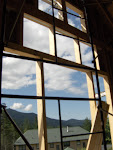 Corralling snow melt or the abundance of rain, before hitting the busy roadway led to the creation of a bio retention swale here at Abode. The objective is to funnel storm water runoff from our paved parking area where there is no curb into a depression or “swale” rather than running directly into the drainage system beside Tenney Mtn. Hwy.
Corralling snow melt or the abundance of rain, before hitting the busy roadway led to the creation of a bio retention swale here at Abode. The objective is to funnel storm water runoff from our paved parking area where there is no curb into a depression or “swale” rather than running directly into the drainage system beside Tenney Mtn. Hwy.To encourage infiltration onsite, a calculation was done by a civil engineer to account for the number of square feet of impervious area (ie: paved parking area, amount of roofing, sidewalks etc.) to determine the amount of pervious surface needed to offset this in the form of a storage system.
Bio-retention systems are shallow depressions made with a layer of sand beneath topsoil to hold captured water and slowly release the excess. This prevents more water from entering the Baker River unfettered, and puts less stress on the drainage ditch.
 A “weir” made of stone rip rap acts as an escape valve for overflow when the swale completely fills, spilling over into the wetland vegetation below. Planted with grasses and other native species that don’t mind being water logged for short periods of time and enjoy longer dry spells reduces erosion, supports a habitat and food source for insects, birds and other wildlife.
A “weir” made of stone rip rap acts as an escape valve for overflow when the swale completely fills, spilling over into the wetland vegetation below. Planted with grasses and other native species that don’t mind being water logged for short periods of time and enjoy longer dry spells reduces erosion, supports a habitat and food source for insects, birds and other wildlife.A similar type of depression known as a rain garden is a means to carry, as well as treat storm water. Excess water is  diverted by the small dry river bed made of small rocks around the house into the rain garden. Plants with deep fibrous roots like this Tamarind tree and wild grasses thrive and provide cleaning and filtration benefits. This hydrated collection area is an attractive area for plants and animals, and keeps water on our property allowing it to slowly seep back down into the aquifer.
diverted by the small dry river bed made of small rocks around the house into the rain garden. Plants with deep fibrous roots like this Tamarind tree and wild grasses thrive and provide cleaning and filtration benefits. This hydrated collection area is an attractive area for plants and animals, and keeps water on our property allowing it to slowly seep back down into the aquifer.
 diverted by the small dry river bed made of small rocks around the house into the rain garden. Plants with deep fibrous roots like this Tamarind tree and wild grasses thrive and provide cleaning and filtration benefits. This hydrated collection area is an attractive area for plants and animals, and keeps water on our property allowing it to slowly seep back down into the aquifer.
diverted by the small dry river bed made of small rocks around the house into the rain garden. Plants with deep fibrous roots like this Tamarind tree and wild grasses thrive and provide cleaning and filtration benefits. This hydrated collection area is an attractive area for plants and animals, and keeps water on our property allowing it to slowly seep back down into the aquifer.An aquifer is essentially an underground body of water that lies well below the surface permeated in porous rock, much like a beach. When you dig a hole in the sand, the wet sand at the bottom of this shallow hole or “well” represents an aquifer. The level the water rises to in the hole would be your water table.
Planning and creating a system to manage excess water runoff gives a twofold benefit. By minimizing destructive erosion to your property and limiting the spillover effect to surrounding land it places less burden on the public drainage system. Slowing down excess reduces the barrage introduced to the nearby river and allows us to contain as much water as possible to our property and ultimately filtered back into the aquifir. Paired with beautiful plantings your quality of life gets a boost along with your property values.
Planning and creating a system to manage excess water runoff gives a twofold benefit. By minimizing destructive erosion to your property and limiting the spillover effect to surrounding land it places less burden on the public drainage system. Slowing down excess reduces the barrage introduced to the nearby river and allows us to contain as much water as possible to our property and ultimately filtered back into the aquifir. Paired with beautiful plantings your quality of life gets a boost along with your property values.

